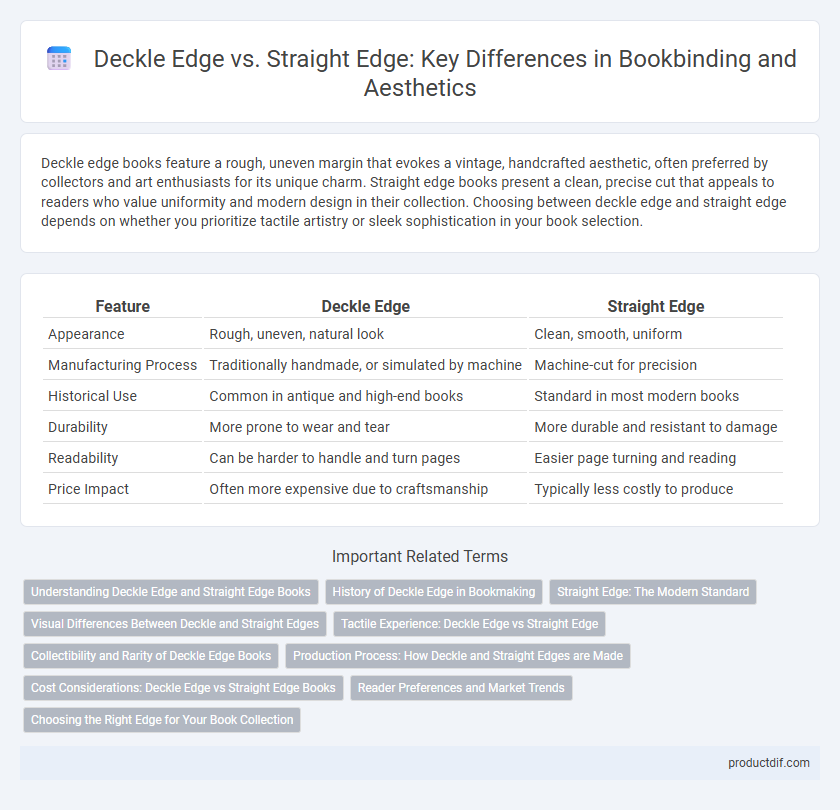Deckle edge books feature a rough, uneven margin that evokes a vintage, handcrafted aesthetic, often preferred by collectors and art enthusiasts for its unique charm. Straight edge books present a clean, precise cut that appeals to readers who value uniformity and modern design in their collection. Choosing between deckle edge and straight edge depends on whether you prioritize tactile artistry or sleek sophistication in your book selection.
Table of Comparison
| Feature | Deckle Edge | Straight Edge |
|---|---|---|
| Appearance | Rough, uneven, natural look | Clean, smooth, uniform |
| Manufacturing Process | Traditionally handmade, or simulated by machine | Machine-cut for precision |
| Historical Use | Common in antique and high-end books | Standard in most modern books |
| Durability | More prone to wear and tear | More durable and resistant to damage |
| Readability | Can be harder to handle and turn pages | Easier page turning and reading |
| Price Impact | Often more expensive due to craftsmanship | Typically less costly to produce |
Understanding Deckle Edge and Straight Edge Books
Deckle edge books feature uneven, feathered page edges that mimic the appearance of handmade paper, adding a vintage or artisanal aesthetic to printed volumes. Straight edge books have clean, smooth, and precisely trimmed pages, offering a modern and polished look favored in most contemporary publishing. The choice between deckle edge and straight edge pages affects book design perception, tactile experience, and collector appeal.
History of Deckle Edge in Bookmaking
The deckle edge, characterized by its rough, uneven finish, originated from traditional paper-making molds where fibers naturally formed irregular borders. Historically, this feature was a byproduct of handmade paper production before industrialization introduced smoother, straight edges through cutting machines. Collectors and bibliophiles often associate deckle edges with antiquity and craftsmanship, valuing them as a mark of authenticity and historical bookmaking techniques.
Straight Edge: The Modern Standard
Straight edge books feature clean, uniform cuts that create a sleek, polished appearance favored in contemporary publishing. This precise trimming method enhances durability by minimizing paper exposure to environmental elements, preserving the book's structural integrity. Straight edges facilitate efficient stacking and shelving, contributing to a professional, modern aesthetic widely preferred by readers and collectors.
Visual Differences Between Deckle and Straight Edges
Deckle edges exhibit an irregular, feathered appearance with uneven, blurry borders that give books a handcrafted, vintage aesthetic. In contrast, straight edges are clean-cut, smooth, and uniform, offering a modern, precise look and feel to the pages. The distinct visual textures of deckle versus straight edges greatly influence the tactile and stylistic impression of printed books.
Tactile Experience: Deckle Edge vs Straight Edge
Deckle edge pages offer a unique tactile experience characterized by their irregular, feathered texture that evokes a sense of handcrafted authenticity, often favored by collectors and enthusiasts for its vintage appeal. In contrast, straight edge pages provide a smooth, uniform feel that enhances ease of handling and readability, commonly preferred in modern publishing for a clean and polished presentation. The choice between deckle and straight edges significantly influences the sensory interaction with a book, affecting both aesthetic perception and user engagement.
Collectibility and Rarity of Deckle Edge Books
Deckle edge books, characterized by their rough, untrimmed page edges, are often prized for their collectibility and aesthetic appeal, adding a sense of authenticity and vintage charm that straight edge books lack. The rarity of deckle edge editions stems from their limited production in modern publishing, making them highly sought after by collectors who value distinctive and unique physical attributes. Straight edge books, with their clean, uniform edges, are more common and typically less valued in the collectible book market compared to the scarce and historically significant deckle edge varieties.
Production Process: How Deckle and Straight Edges are Made
Deckle edges are created through a traditional papermaking method where the pulp is poured into a frame called a deckle, allowing fibers to settle unevenly and produce a rough, feathered edge. Straight edges result from modern cutting techniques, often using guillotine cutters or laser cutting, which slice the paper cleanly and uniformly. The deckle edge emphasizes artisanal texture due to its handcrafted origins, while straight edges reflect precision and consistent mass production.
Cost Considerations: Deckle Edge vs Straight Edge Books
Deckle edge books often incur higher production costs due to the labor-intensive process of creating uneven page edges, which can increase pricing compared to straight edge books. Straight edge books benefit from more efficient manufacturing techniques, resulting in lower production expenses and more affordable retail prices. The choice between deckle edge and straight edge books should factor in budget constraints alongside aesthetic preferences.
Reader Preferences and Market Trends
Deckle edge books evoke a nostalgic, artisanal feel that appeals to readers seeking a unique tactile experience, often associated with limited editions or collectors' items. Straight edge books dominate the market due to their clean, uniform appearance and compatibility with mass production, aligning with mainstream consumer preferences for convenience and affordability. Market trends show a growing niche demand for deckle edges among literary enthusiasts, while straight edges continue to cater to the general readership driven by practicality and cost-efficiency.
Choosing the Right Edge for Your Book Collection
Deckle edge books feature uneven, feathered page edges that evoke traditional craftsmanship, giving collectors a vintage or artisanal feel. Straight edge books present clean, uniform lines ideal for modern aesthetics and ease of shelving, appealing to those who prioritize sleek design and practicality. Choosing between deckle edge and straight edge depends on whether you value historical charm or contemporary precision in your book collection.
Deckle edge vs Straight edge Infographic

 productdif.com
productdif.com